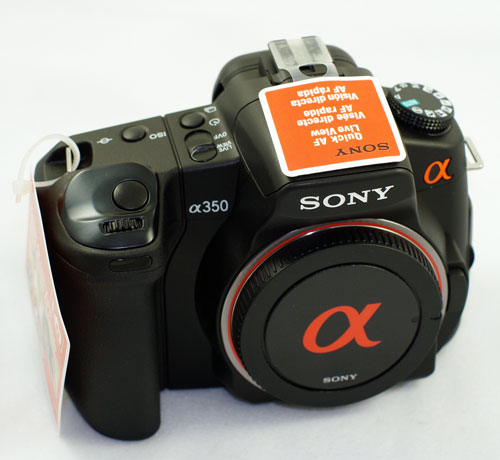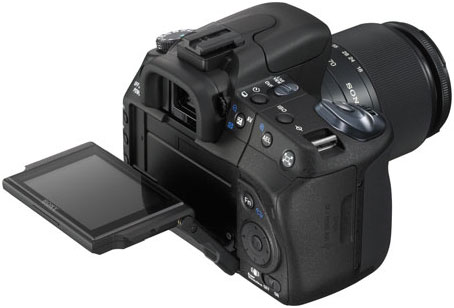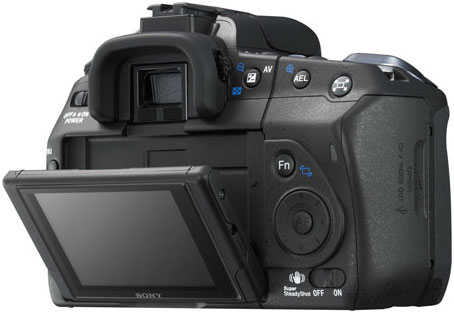Sony A350: Full-Time Live View at 14.2MP
by Wesley Fink on April 3, 2008 3:00 AM EST- Posted in
- Digital Camera
Features and Handling
Sony is used to playing in the large volume retail space where every trick used to gain visibility can result in higher sales.

This is very clear in the packaging theme for Sony DSLR cameras and accessories. No one will miss the bright orange and white (or bright orange and silver) that makes the Sony packages stand out.

The A350 body is on the small side, like the other Sony entry DSLR models, without the extreme smallness that seems to some a problem with the Canon XTi or Nikon D60/D40x. The new Canon XSi is a bit larger than the previous model to address size complaints and accommodate a 3.0" LCD. The Sony A350 is both a little wider (5.25" vs. 5.1") and taller (4.0" vs. 3.8") than the upsized XSi. Minolta pioneered body-integral image stabilization, and the evolved Sony Super Steady Shot is a feature on every Sony DSLR, along with auto sensor cleaning.
The top deck contains a single dial to adjust mode (full-auto, program, shutter-priority, and aperture-priority) and a wide selection of special scene programs such as portrait, sports, night, etc. On the opposite side of the viewfinder hump you will find a mechanical (no power required) Live View/OVF (Optical Viewfinder) switch, timer/drive mode button, and ISO button. The shutter release and shift/adjust dial are on top of the comfortable handgrip.

9-point auto-focus is featured on the A350. The layout and pattern is the same as the A200, A300, and earlier A100 suggesting it is the same AF module. The burst AF speeds on all models also support the conclusion that this is likely the same venerable AF module used in previous Minolta and Sony digital SLRs. Sony claims faster AF in the newest models, and that is likely the result of faster data processing in the supporting data processing modules in the DSLR. The prosumer A700 uses an updated and faster 11-point AF system. The A350 AF system is very competitive in its class and a big step up from the Olympus 510/410/420 and Nikon D60/D40x 3-point AF modules.


While the A350 is a bit larger than the Canon XSi, the LCD is 2.7" instead of the 3.0" LCD featured on the XSi. However, it is the only LCD in its class that is articulated, allowing an upward tilt as far as perpendicular for low-level shots and a down tilt to allow holding the camera above your head for crowd shots. These kinds of shooting situations require a contortionist on the usual DSLR and they are a great benefit for the capable and fast Sony Quick AF Live View. The LCD brightness is adjustable up and down, but it was still a challenge to read info on the LCD in bright sunlight. Perhaps some aftermarket LCD hood will improve LCD viewing.

The rear finds the on-off switch to the left of the viewfinder, which is typical of all the current Sony models. To the right of the viewfinder are the metering pattern/exposure compensation button, AEL (exposure lock)/zoom button, and the unique auto teleconverter. The teleconverter switch just takes advantage of the high-resolution sensor to give you instant 1.4x and 2x crops of the regular image. It does not add or interpolate pixels.
The main part of the a350's back is dominated by the 2.7" tilt screen, and the expected MENU, DISPlay, Delete (Trash Can), and Playback buttons to the left of the screen. To the right is the extremely useful Fn (function) button, which brings up the most commonly used adjustments to allow quick adjustments without searching through menus. The up/down/select multi-controller is used to navigate menus and the screen and a Super Steady Shot on/off switch complete the rear controls.
The sensors at the bottom of the viewfinder are the trademark Minolta "auto-on" when you bring the viewfinder toward your face in OVF mode. There is also a small knurled wheel to adjust viewfinder focus to match your eyesight. This former high-end feature is now making its way into almost all of today's DSLR cameras.
Handling
The A350 is an entry-level camera despite some high-end features like the 14.2MP sensor. As such, it is designed to be easy to use. Ours came out of the package setup at the factory for Live View mode with Super Steady Shot on. In general, Sony made the controls very easy to use and figure out. Sony tells us one complaint from buyers moving from point-and-shoot digital cameras to a digital SLR is that they are often overwhelmed by the controls of the DSLR. Point-and-Shoot users will find the A350 easy to use and familiar right out of the box.
Another editor at AnandTech ordered the A350 from SonyStyle as soon as he saw the specifications in our PMA reporting. He received his A350 last week and commented that the controls on the A350 were extremely easy to figure out and use. He said after 15 minutes he felt like he could figure out most everything on the camera and he was ready to "shoot like a Pro" with the A350. If other new users also find this kind of "instant comfort" with the A350, it will become a big seller.










113 Comments
View All Comments
dug777 - Monday, March 31, 2008 - link
I would also simply suggest using a time-delay shot if you don't have a wireless or wired shutter release :)dug777 - Monday, March 31, 2008 - link
That or they're out of focus?Heidfirst - Monday, March 31, 2008 - link
Interesting review as usual with a more general consumer orientated view as compared to some of the more "specialist" DSLR sites, thank you.A vies notes, if I may:
"For those who wish to buy the body alone, only the A350 ($799) and A700 ($1399) are available without a kit lens"
I realise that Anandtech is USA-centric but also does get significant traffic from other countries - this varies from country to country according to local Sony marketing decisions e.g. if I want to buy an A200 body only in the UK that's not a problem.
Often the street (as opposed to msrp) prices for the basic kit 18-70mm package are so little more than body only though that you may as well get the 18-70 too.
"The layout and pattern is the same as the A200, A300, and earlier A100 suggesting it is the same AF module. The AF speeds on all models also support the conclusion that this is likely the same venerable AF module used in previous Minolta and Sony digital SLRs. "
Sony claim 1.7x faster focussing (probably largely as a result of using a more powerful motor but also a tweaked system).
Probably little has changed because the basic Minolta metering & AF system going back 20 years or so has been a very good base & only required minimal tweaks/upgrades.
Re. the battery:
If you compare Sony NP-FM500H prices it's similar to those for the official Canon, Nikon, Pentax etc. batteries so the issue isn't really the pricing of the official batteries but the unavailability of generic copies.
When I bought my A700 I also bought a spare battery but I've never actually had to use it as battery life has been very good. Extensive Live View use on an A300/A350 may use more I would imagine though.
At least Sony now have a standard battery throughout their DSLR range whereas on Canon & Nikon as you upgrade bodies you change batteries so you can't carry them over but must buy new.